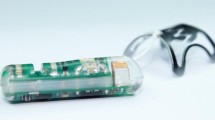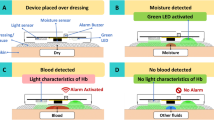Abstract
Background
An acute upper gastrointestinal bleeding event is an emergency situation which requires immediate endoscopic assessment and treatment. A new telemetric real-time intracorporeal bleeding sensor can help in the timely diagnosis of an acute upper gastrointestinal bleeding event: The sensor capsule, HemoPill, is swallowed by the patient if gastrointestinal bleeding is suspected. Information about the bleeding status is displayed by telemetric communication of the capsule with an extracorporeal receiver. This is the first evaluation of the HemoPill to detect blood in the upper human gastrointestinal tract.
Methods
A voluntary test person ate a defined meal with or without the adjunct of his own blood for a total of eight times and afterward swallowed the sensor capsule. The collected spectrometric receiver data were analyzed to assess whether the sensor system was capable of detecting blood and to evaluate the effect of stomach content as an artifact.
Results
With its optical sensor, the HemoPill was able to reliably indicate the ingested blood in the stomach. The data transmission from the swallowed sensor capsule to the extracorporeal receiver was achieved consistently. The evaluation of diverse concentrations of ingested blood and the respective sensor signals led to an exponential relationship of these variables. This relationship allows to define thresholds for categories indicating the likelihood of blood presence in the gastrointestinal tract.
Conclusions
The HemoPill is a valuable tool to detect an acute upper gastrointestinal bleeding event without the need of endoscopy.






Similar content being viewed by others
References
Schostek S, Zimmermann M, Keller J, et al. Telemetric real-time sensor for the detection of acute upper gastrointestinal bleeding. Biosens Bioelectron. 2016;78:524–529.
Lim LG, Ho KY, Chan YH, et al. Urgent endoscopy is associated with lower mortality in high-risk but not low-risk nonvariceal upper gastrointestinal bleeding. Endoscopy. 2011;43:300–306.
Gralnek IM, Barkun AN, Bardou M. Management of acute bleeding from a peptic ulcer. N Engl J Med. 2008;359:928–937.
Laine L, Jensen DM. Management of patients with ulcer bleeding. Am J Gastroenterol. 2012;107:345–360.
Terdiman JP, Ostroff JW. Risk of persistent or recurrent and intractable upper gastrointestinal bleeding in the era of therapeutic endoscopy. Am J Gastroenterol. 1997;92:1805–1811.
National Clinical Guideline Centre (UK). Acute Upper Gastrointestinal Bleeding: Management. NICE Clinical Guidelines, No. 141. London: Royal College of Physicians (UK); 2012 Jun.
Krige JE, Kotze UK, Distiller G, et al. Predictive factors for rebleeding and death in alcoholic cirrhotic patients with acute variceal bleeding: a multivariate analysis. World J Surg. 2009;33:2127–2135.
De Gottardi A, Dufour JF. Oesophageal and fundic variceal bleeding. Ther Umsch. 2006;63:295–299.
Shimohira M, Hashizume T, Ohta K, et al. Triaxial transarterial embolization for lower gastrointestinal bleeding: a retrospective case series. Minim Invasive Ther Allied Technol. 2015;24:119–122.
Lomanto D, Wijerathne S, Ho LK, et al. Flexible endoscopic robot. Minim Invasive Ther Allied Technol. 2015;24:37–44.
Azizi Koutenaei B, Wilson E, Monfaredi R, et al. Robotic natural orifice transluminal endoscopic surgery (R-NOTES): literature review and prototype system. Minim Invasive Ther Allied Technol. 2015;24:18–23.
Schostek S, Schurr MO. The HemoCop Telemetric Sensor System: technology and results of in vivo assessment. Stud Health Technol Inform. 2012;177:97–100.
Funding
Ovesco Endoscopy AG received funding from the European Commission: Project title “Versatile Endoscopic Capsule for gastrointestinal TumOr Recognition and therapy Contract” (Grant No. 033970) and the German Federal Ministry BMWI: Project title “Miniaturisierte Funkschnittstelle zur zuverlässigen drahtlosen Datenübertragung aus dem menschlichen Körper” (Grant No. EP120781).
Author information
Authors and Affiliations
Corresponding author
Ethics declarations
Conflict of interest
Sebastian Schostek, Thomas Gottwald, and Marc O. Schurr hold management positions for Ovesco Endoscopy AG. Melanie Zimmermann, Jan Keller, Mario Fode, Michael Melbert are employees of Ovesco Endoscopy AG. Ruediger L. Prosst has no conflict of interest.
Rights and permissions
About this article
Cite this article
Schostek, S., Zimmermann, M., Keller, J. et al. Volunteer Case Series of a New Telemetric Sensor for Blood Detection in the Upper Gastrointestinal Tract: The HemoPill. Dig Dis Sci 61, 2956–2962 (2016). https://doi.org/10.1007/s10620-016-4226-y
Received:
Accepted:
Published:
Issue Date:
DOI: https://doi.org/10.1007/s10620-016-4226-y




